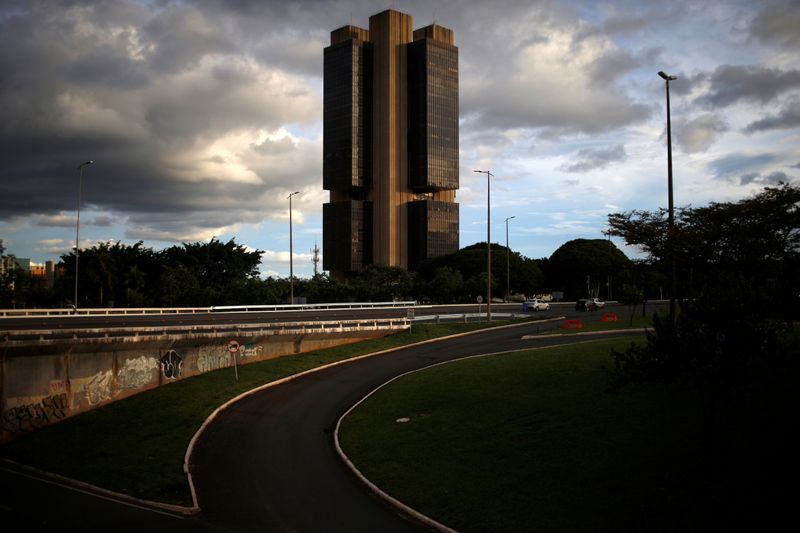BRASILIA (Reuters) – Despite a spike in Brazil’s long-term interest rates serving as a “warning” to remedy public finances, the central bank’s record low official interest rate means there is little risk – if any – to the government’s ability to service its ballooning debt.
The steepening of the Brazilian rate curve reflects investors demanding higher premiums to lend longer term to the government due to growing worries over its ability to reduce record pandemic-fueled borrowing.
Treasury Secretary Bruno Funchal told Reuters this week the spike in market-based rates was a “warning” and said policymakers have “no room for error” to return to fiscal discipline.
That, at least, is the orthodox narrative.
But as the Treasury admits, the slide in the central bank’s key Selic interest rate since last year to 2.00% has brought the average cost of funding the federal public debt to its lowest on record.
As the minutes of the central bank’s last policy meeting showed on Tuesday, the Selic is unlikely to be raised for a very long time, and could even be reduced further.
As long as the Selic stays ‘lower for longer’, the Treasury’s shift in strategy to increase short-term debt issuance could also help put a cap on borrowing costs.
“Brazil is facing an unprecedented scenario of very low interest rates for a very long time,” said Monica de Bolle, senior fellow at the Peterson Institute for International Economics in Washington. “This buys the country a lot of time to adjust the fiscal accounts and adopt a lot of imprudent policies.”
“We’re not in the 1980s anymore,” she said.
RECORD LOW FUNDING COSTS
The difference between near- and longer-term borrowing costs on many parts of the Brazilian interest rate curve is the widest since the height of the public health and economic crisis earlier this year. Spreads are close to breaching even these historic peaks.
But as the chart below from the Treasury shows, the average cost of servicing the federal debt and new borrowing in July was historically low. With the Selic having been cut further since then, it will likely be even lower.
The average cost of servicing the overall stock of federal domestic debt in the 12 months to July was 7.4%. At the end of last year, it was 8.7%, and four years ago it was 14%.
Similarly, the average cost of issuing new federal domestic debt in the 12 months through July was 5.1%, compared with almost 7% at the end of last year and over 14% four years ago.
(GRAPHIC: Brazil’s average cost of funding – https://fingfx.thomsonreuters.com/gfx/mkt/bdwpkkzajpm/TREASURY1.png)
Ratings agency Moody’s, more vocal than most on the need to reduce deficits and debt, said on Wednesday that Brazil’s government has benefited hugely from record low interest rates, and will continue to do so.
“(Brazil’s) debt affordability has improved significantly, dropping to 18% in 2019 from nearly 30% in 2015. We expect this ratio to continue to improve in 2021,” Moody’s said in a note, referring to interest payments as a share of government revenue.
“Considering Brazil’s large stock of debt, the drop in interest rates has a material positive impact on its credit quality,” it added.
Brazil’s government expects to amass a primary budget deficit this year of 866 billion reais ($158 billion), more than 12% of gross domestic product, with some private sector economists pegging the shortfall closer to 1 trillion reais.
This will swell the accumulated gross debt close to 100% of GDP, from 76% at the end of last year, also a record and significantly higher than most emerging economies.
This has forced Treasury to raise more funds via short-term issuance, a potentially risky strategy highlighted by some failed floating-rate ‘LFT’ debt auctions lately. On Friday, investors bought only a fifth of the LFT notes on offer.
But Treasury officials appear relaxed. Luis Felipe Vital, head of public debt operations, played down the recent weak demand for LFT paper and said shorter-term borrowing is “super positive” for the Treasury in terms of cost.
Similarly, the steep curve does not appear to be an issue either.
“Even though premiums have clearly increased recently, the cost to the Treasury remains historically low,” Vital told Reuters. “Are higher premiums a cost issue for the Treasury? Not at all. Treasury (funding) costs are the lowest since our series began.”
The Treasury needs to refinance some 835 billion reais of federal public debt maturing in the next 12 months, and 889 billion reais in calendar 2021, central bank figures show.
These are big numbers. But with interest rates so low, they are manageable.
(Reporting by Jamie McGeever; Editing by Stephen Eisenhammer, Daniel Flynn, Bernadette Baum and Diane Craft)





















